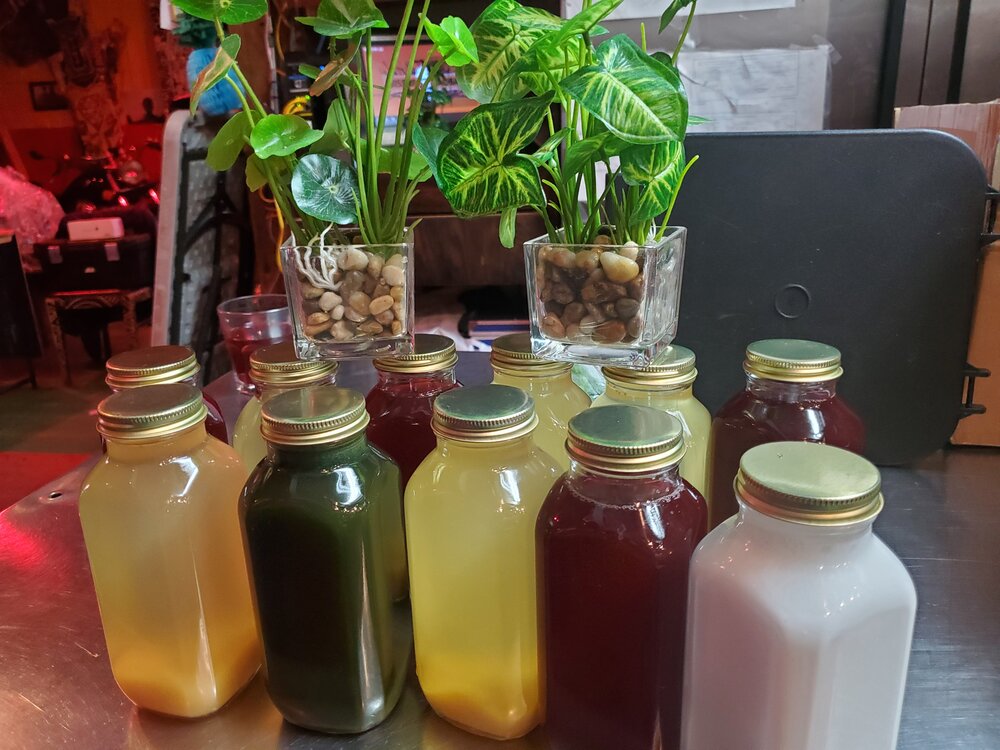Image: The Diata, Shaka, and Akhenaton drinks from Bissap Baobab; learn more about their history-infused origins here.
Just a year ago, legendary Senegalese dance hall Bissap Baobab bid an emotional farewell to San Francisco when it closed its doors after 20 years in business. On its final night ever, Bissap Baobab hosted a party attended by hundreds, celebrating the establishment’s journey from a small Mission District kitchen to a world-famous venue. Bass-boosted Latin and African hits boomed with undeniably infectious energy as patrons danced the night away one last time. The tears didn’t pour out as smoothly as the homemade coconut rum, but they showed it didn’t feel right to see a revered local landmark fade away.
Owner Marco Senghor had no intention to move on from the business. Bissap Baobab afforded him a clear path to celebrate his native Senegal and its cultural customs in the United States. And, of course, it helped him find success in an ever-competitive market for restaurants in San Francisco. While financial debt left him with no choice but to sell his prized possession, he still yearned to revitalize the Baobab concept that moved so many.
Then Little Baobab was born.
Little Baobab
Using a portion of Bissap Baobab’s previous space on 19th St., Senghor refuses to succumb to the pressure of creating a sequel better than the original. Instead, he reincarnates the spirit of what the original felt like back when he first launched it in 1996. Senghor feels like he is traveling back to the days when Baobab was still striving to become the global name it is today. Despite their differences, the commonalities between the old and new versions speak to Senghor’s same mission all along.
“People love to come in there because we kind of show them that it wasn’t about the food, but the people that capture the music, the energy and the palace. So it was a whole package,” said Senghor.
Little Baobab doesn’t feel minimalistic for the wrong reasons. With a back-to-basics approach, the venue thrives on its authenticity and history. Much like the baobab tree, a short African tree known for its thick trunk and fruits, Little Baobab gives more life to the Mission District and the rest of San Francisco. Creole, West Indian, and West African dishes comprise an eclectic menu. Homemade juices with ginger and hibiscus also provide an unparalleled zest with recipes that Senghor mastered in his previous days running a beverage company. The kitchen takes up more space, and the dance floor is a bit smaller, allowing event crowds to build quickly and enjoy the fruits of an intimate environment.
By focusing on what Baobab always knew, Senghor has been pulling off a well-deserved comeback. But COVID-19’s timing has made the pandemic even more stressful for the owner during Little Baobab’s revival. Just like he did with Bissap Baobab, he faces additional challenges with overhead costs. Plus, Senghor has not received a PPP loan, which has proven notoriously difficult for restaurants to obtain.
“So it was really tough because we had to shut down for some time. Being on my neighbor’s board at night for the restaurants who have voted for me, it was difficult to face as a leader for a long time,” said Senghor.
Community and COVID-19
The National Restaurant Association claims restaurants lost over $20 billion during the first three weeks of the pandemic. However, less than 16 percent of small businesses who’ve applied for Paycheck Protection Program (PPP) loans have received them, according to the COVID Loan Tracker website.
The lack of federal aid has put San Francisco’s restaurant owners in a position where they have to depend on programs like the SF New Deal to stay in business. However, Senghor remains positive. The Deal’s concept is a perfect fit for Baobab’s community-driven brand ethos, which the humble restaurant owner looks forward to building from. In discussing an opportunity that he had through the SF New Deal to feed the homeless, it’s clear that Senghor’s heart is aligned with his community. People don’t forget that.
The sooner this pandemic ends, the quicker Senghor can play a role in revolutionizing the local economy. He wants to create a new economic model for small restaurants that would raise money for others, which could help in mitigating San Francisco’s class divide amid rampant gentrification. Until then, he’s focused on overcoming expensive rents in the Mission District and remaining true to the spirit of Little Baobab.






Thanks for sharing. I read many of your blog posts, cool, your blog is very good.
I don’t think the title of your article matches the content lol. Just kidding, mainly because I had some doubts after reading the article.
Thanks for sharing. I read many of your blog posts, cool, your blog is very good.
Thank you for your sharing. I am worried that I lack creative ideas. It is your article that makes me full of hope. Thank you. But, I have a question, can you help me?
I am sorting out relevant information about gate io recently, and I saw your article, and your creative ideas are of great help to me. However, I have doubts about some creative issues, can you answer them for me? I will continue to pay attention to your reply. Thanks.
Can you be more specific about the content of your article? After reading it, I still have some doubts. Hope you can help me.